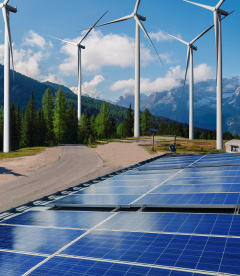To Keep the Power Flowing
Application
January 20. 2024
2 min.
As electricity travels to the consumer, its voltage gradually increases and decreases by several orders of magnitude, which is taken care of by a whole chain of transformer stations. Fail one and you're without power, so they're backed up by battery systems.

Large power plants as well as turbines in general produce electricity at relatively low voltages of single digits of thousands, or, at most, a few tens of thousands of volts. Due to the nature of AC current, transmitting it over long distances would result in significant Joule losses due to conductor heating, so the voltage of the AC electricity produced is first increased by about an order of magnitude with step-up transformers. This reduces the resistive heat by the square of the voltage drop, that would be by two orders of magnitude in this case.
AC transmission over low to medium distances, typically up to hundreds of kilometers, is therefore carried out at voltages of many hundreds, or sometimes even over a thousand kilovolts to reduce line losses. With slightly lower voltages used for medium distances, for example 110 kV, as it is customary in Europe. Transformer stations on the outskirts of towns then further reduce the voltage of the electricity transmitted to between 66 and 11 kV for industrial customers and subsequent domestic distribution. At the last hundreds of meters before the end of its journey to households, the voltage is further stepped down to 400/230 V.
These smallest substations can be located underground in densely populated areas, while historic substations can take the form of a brick tower with a flat or gabled roof. But most often, this kind of substation can be seen at the end of the street in the form of a refrigerator-sized container in Europe, or resembling an old-fashioned trash can in the US, mounted on the cantilever of a power line pole. These transformers don't need a backup power source in the form of an auxiliary power system. Instead, they only have a small battery, usually 12 or 24 volts, which allows for emergency shutdown and bridging of the transformer for maintenance purposes.
However, medium-sized substations that convert electricity from or to 110 kV, or at least higher tens of kilovolts, handle much higher workload. In order for them to cover brownouts and other disruptions within the incoming mains electricity, they would require impractically large batteries, so this is not an option. These substations are equipped with smaller 48 or 110 V DC batteries with some 200-300 Ah of capacity, but instead of being connected to the primary power line, they serve as the facilities' uninterruptible power supply units.
Often found on the outskirts of towns and cities, 110 kV or so substations cover an area comparable to the size of a soccer field. There, usually one or two, sometimes three main output transformers rise amidst an array of circuit breakers, regulators or reclosers (isolators and relays), next to which a control building stands. And all of this equipment needs to be tripped instantly to isolate and protect the transmission or distribution infrastructure in an event of incoming power surge.
In such case, the batteries take over to supply operation backup power for the duration of up to 4, or even 8 hours in order to keep the switchgear control equipment live for line monitoring and SCADA communications. When the incoming power normalizes, the battery keeps on providing additional back-up power to relays and breakers to close the circuits to continue safe operations. In fact, there is quite a long list of equipment which needs to be constantly powered in a larger substation, and therefore, these facilities are often equipped with several UPSs at a time. Find out more in an article soon to be published on GAZ Academy.
Similar articles
Why Stabilizing the Grid can be done so Efficiently with Batteries
March 27. 2025
2 min.
ViewElectric Buses on the fast Track
March 4. 2025
2 min.
ViewEasy Riding with Battery Power
February 13. 2025
2 min.
ViewMaking Water Flow with Batteries
November 8. 2024
2 min.
View



